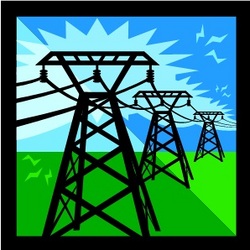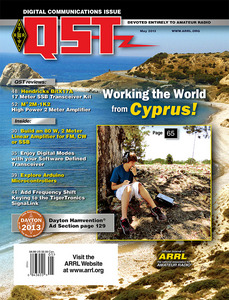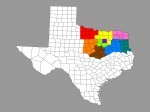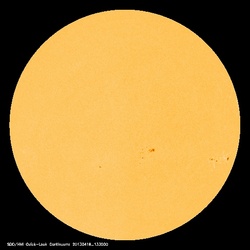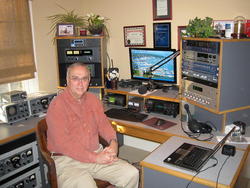 April 18, 2013 John E. Ross, KD8IDJ, Editor
| ||||||||
+ Available on ARRL Audio News. + BPL: FCC Again Denies ARRL's Petition in BPL Proceeding On April 16, the FCC issued a Second Memorandum Opinion and Order, denying the ARRL's December 2011 Petition for Reconsideration that sought reconsideration of the FCC's Second Report and Order, "fundamentally affirm[ing]" its rules for Access Broadband over Power Line (Access BPL) systems. In denying the ARRL's Petition, the FCC noted that the Petition "[did] not raise new arguments based on new information in the record or on the Commission's new analysis of limited points as directed by the Court, nor does it demonstrate any errors or omissions in the Commission's previous decisions," and that its previous rulings "strike an appropriate balance between the dual objectives of providing for Access BPL technology -- which has potential applications for broadband and Smart Grid uses -- while protecting incumbent radio services against harmful interference."
The ARRL made 14 principal points in its Petition, each of which was aimed at urging the FCC to enact additional rules that would permit BPL systems to operate without the severe interference potential inherent in BPL technology. The ARRL argued that the current rules do not address this severe interference potential, which was manifested in every deployment of BPL in which the safeguards urged by the ARRL were absent. The FCC dismissed all of the ARRL's arguments, claiming that the ARRL "did not submit any new information," made "no new argument" or that it had, in the Commission's view, failed to make its point. ARRL General Counsel Chris Imlay, W3KD, said that full time, mandatory notching of amateur bands to a notch depth not less than 25 dB was "the least that the FCC should have required in its rules, because interference prevention is possible; post-hoc remediation is not. In this instance, the FCC has not acted responsibly in its stewardship of the MF and HF radio spectrum. The ARRL will continue to vigilantly guard against the abuse and pollution of the radio spectrum in the use of BPL technology on a case-by-case basis as necessary, wherever necessary." Read more. + Public Service: Radio Amateurs Provide Communication Support in Boston Marathon Bombings
As has happened many times in years past, over 200 Amateur Radio operators participated in communications for the Boston Marathon on Monday, April 15, 2013. Unlike prior challenging situations such as very warm weather for the runners or other weather-related challenges, this year's marathon will be remembered for the bombings that took place at the finish line. Despite this heinous act, professional first responders, medical volunteers from the American Red Cross that staffed the route, and Amateur Radio operators performed magnificently in the face of adversity. "Within minutes, cell phone systems became overloaded and making phone calls and text messages was difficult. Amateur Radio operators performed communication duties under duress and performed admirably. No Amateur Radio volunteers were injured on the course in this terrible act," said Steve Schwarm, W3EVE, who is the Amateur Radio Course Communication Coordinator and associated with a consortium of clubs and groups known as Marathon Amateur Radio Communications (MARC). Read more. + FCC Enforcement: FCC Issues Two Forfeiture Notices for Cell Phone Jamming
On April 9, the FCC found two businesses -- The Supply Room in Oxford, Alabama and Taylor Oilfield Manufacturing in Broussard, Louisiana -- to have "apparently willfully and repeatedly violated" the FCC's rules operating multiple cellular phone jammers that were illegally imported to the US. The FCC issued a Notice of Apparent Liability for Forfeiture and Order (NAL) to each business: The Supply Room received an NAL in the amount of $144,000, while Taylor Oilfield Manufacturing received an NAL in the amount of $126,000. Read more. + Check Out the May Issue of QST The May issue of QST -- our annual digital communications issue -- explores the fun and excitement that awaits radio amateurs on the digital modes. So grab your print edition of QST -- or settle in with your computer or tablet to read the digital version -- and discover what the May issue has to offer. Following up on his January 2013 article "Cheap and Easy SDR," Robert Nickels, W9RAN, explains how to integrate SDR and digital operation. In "Digital Modes for Your SDR," Nickels shows how your PC can serve as an SDR engine to receive digital modes. Using Arduino -- an open-source electronics prototyping platform based on flexible, easy-to-use hardware and software -- Roger Shipley, KA9NAH, talks about his entry into the world of microcontroller programming in his article "Microcontrollers -- No Experience Necessary."
In 2012, 15-year-old Padraig Lysandrou, KC9UUS, convinced his family that the perfect vacation would be a DXpedition to Cyprus -- and they agreed! In his article "A Crazy Idea: DXpedition to Cyprus," Lysandrou tells about how he coordinated logistics and made QSOs on the beautiful island. With a laptop computer, a loop antenna and a low power SDR radio, Dennis Lazar, W4DNN, brought high tech to a North Carolina mountaintop. In his article "SDR at the Summit," Lazar describes how he activated 5600-foot-high Craggy Knob for the Summits on the Air (SOTA) awards program. ARRL Senior Test Engineer Bob Allison, WB1GCM, takes a look at the Hendricks BitX17A 17 meter SSB transceiver kit in this month's Product Review. He says this kit is "challenging to build and rewarding to use. The finished radio sounds great on the air, although some operators will have to get used to having no AGC on receive." QST Contributing Editor Jeff Klein, K1TEO, checked out the M2 2M-1K2 high power 2 meter amplifier, calling it a "quiet and convenient solution for high power operation on 2 meters. It puts out near legal limit power and is compatible with most modern transceivers or transverters." You can find a video overview of the Hendricks BitX17A 17 meter SSB transceiver kit and the M2 2M-1K2 high power 2 meter amplifier in the digital edition of the May issue of QST. Of course, there are the usual columns you know and have come to expect in the May issue of QST: Happenings, Hints & Kinks, Eclectic Technology, The Doctor is In, Technical Correspondence, Short Takes, Vintage Radio, How's DX? and more. Look for your May issue in your mailbox and in your inbox. QST is the official journal of the ARRL, the national association for Amateur Radio. QST is just one of the many benefits of ARRL membership. To join or to renew your ARRL membership, please see the ARRL web page. + Section News: New Section Manager Appointed in North Texas
Chris Brewer, N5GMJ, of Saginaw, Texas, has been appointed ARRL North Texas Section Manager as of April 30. The current Section Manager, Walt Mayfield, KE5SOO, of Krum, announced he would be resigning due to work and family commitments; he has served as Section Manager since October 2011. ARRL Membership and Volunteer Programs Manager Dave Patton, NN1N, appointed Brewer after consulting with ARRL West Gulf Division Director David Woolweaver, K5RAV. Brewer, who is presently the Official Observer Coordinator in the North Texas Section, has been an Official Observer since 2009. He will complete the current term of office as North Texas Section Manager that continues through March 31, 2015. Solar Update
Tad Cook, K7RA, reports: While solar activity weakened this past week, geomagnetic conditions were stable. The geomagnetic storm predicted for last weekend did not happen, and both the planetary and mid-latitude A index only rose to 10 on April 14 in response to a glancing blow from a coronal mass ejections (CME). The average daily sunspot numbers declined nearly 25 points to 113.3, while the average daily solar flux was down more than 17 points to 121.7. The predicted flux values for the near term are 100 on April 18-19, 95 on April 20-21, 90 on April 22-23, 95 and 105 on April 24-25, 110 on April 26-28, 115 on April 29-30, 120 on May 1-2, 125 on May 3-6, 120 on May 7-8, and down to 115 for May 9-12. The predicted planetary A index is 5 on April 18-22, 12 and 8 on April 23-24, 15 on April 25-26, 5 on April 27 to May 4, 8 on May 5, 5 on May 6-11, and rising to 8 on May 12. Look for more information on the ARRL website on Friday, April 19. For more information concerning radio propagation, visit the ARRL Technical Information Service Propagation page. Jay Adrick, K8CJY, Honored at NAB Show
The National Association of Broadcasters (NAB) awarded its NAB Television Engineering Achievement Award for 2013 to Jay Adrick, K8CJY, at NAB Show in Las Vegas. Established in 1959, the peer-nominated NAB Engineering Achievement Awards are given for significant contributions to advancing broadcast engineering. Adrick, an ARRL Life Member from Cincinnati, Ohio, retired earlier this year from the Harris Corporation where he was Vice President of Broadcast Technology in the company's CTO Group. Prior to beginning his career with Harris, Adrick taught Broadcast Communications at Ohio's Xavier University and was Director of its Radio/TV program. He also served as an engineer and design consultant to radio and TV stations in several Ohio markets. Read more. This Week in Radiosport This week:
Next week:
All dates, unless otherwise stated, are UTC. See the ARRL Contest Branch page, the ARRL Contest Update and the WA7BNM Contest Calendar for more information. Looking for a Special Event station? Be sure to check out the ARRL Special Event Stations web page. Upcoming ARRL Section, State and Division Conventions and Events
To find a convention or hamfest near you, click here. ARRL -- Your One-Stop Resource for Amateur Radio News and Information Join or Renew Today! ARRL membership includes QST, Amateur Radio's most popular and informative journal, delivered to your mailbox each month. Subscribe to NCJ -- the National Contest Journal. Published bi-monthly, features articles by top contesters, letters, hints, statistics, scores, NA Sprint and QSO Parties. Subscribe to QEX -- A Forum for Communications Experimenters. Published bi-monthly, features technical articles, construction projects, columns and other items of interest to radio amateurs and communications professionals. Free of charge to ARRL members: Subscribe to the ARES E-Letter (monthly public service and emergency communications news), the ARRL Contest Update (bi-weekly contest newsletter), Division and Section news alerts -- and much more! Find us on Facebook. Follow us on Twitter. ARRL offers a wide array of products to enhance your enjoyment of Amateur Radio. Donate to the fund of your choice -- support programs not funded by member dues! Click here to advertise in this newsletter (subject to space availability). | ||||||||
